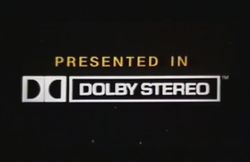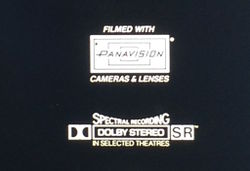| Welcome to Sprocket School! This project is maintained by volunteer editors. Learn more about how this works. |
Dolby A
Dolby A is a noise reduction process created by Dolby Laboratories. It is used in many aspects of analog recording but for the purposes of Sprocket School we will be talking exclusively about its use with 35mm and 70mm film prints. Dolby A can be used to refer to the noise reduction process itself, or to the four channel sound format – left, center, right and surround. It was in use from approximately 1975 to 1986, when it was largely replaced by Dolby SR.
Dolby A vs. Dolby SR
Dolby A is difficult to distinguish from Dolby SR by sight. Here are some tips on telling them apart:
- Many studio films made between 1975 and 1985 will have Dolby A tracks.
- Some (but not all) films with Dolby A tracks will display the word "Dolby" - or "Dolby Stereo" rather than "Dolby SR" - with the Dolby logo in the end credits. But be careful, just because you see one of these in the credits of the film does not guarantee that it is A Type or SR. Some films were released as both mono and stereo prints, or a film may have been re-mastered and released as SR but was originally mono. Seeing the logo in the credits is just another clue to be used with alongside other sources of information.
- Some (but not all) films with Dolby A tracks will display the words "Stereo" on the edges of the film leader.
- A Dolby A track played in Dolby SR will usually sound harsh or blown out
-
Dolby Stereo logo.
-
Dolby Spectral Recording logo (SR)
External Links
- Wikipedia: Dolby SR
- Wikipedia: [Dolby Pro Logic]

